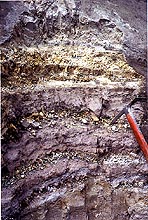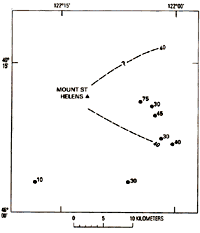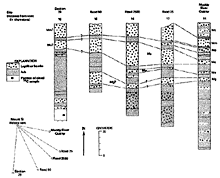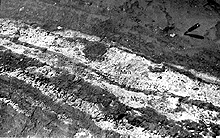
PRE-1980 TEPHRA-FALL DEPOSITS ERUPTED FROM MOUNT ST. HELENS, WASHINGTON
By Donal R. Mullineaux
U. S. Geological Survey Professional Paper 1563
Tephra Set M
Set M, which is about half the thickness of set C, is made up of several
yellowish-brown to gray pumice and lithic lapilli layers, a few centimeters to about 15 cm thick, that are interbedded
with purplish-gray to brown ash beds (figs. 12, 13).
As a whole, the set typically is recognizable as a sequence of thin lapilli layers interbedded with the purplish-hued
ash. Pumice lumps in set M commonly are weathered enough to be soft and easily broken by hand, though they are
less weathered than pumice in set C. No oxidation profiles were identified within set M.
|

Figure 12. Typical colors of lapilli layers and interbedded ash in tephra set M 9 km east of Mount St.
Helens. Yellowish-brown pumiceous layers Mm and Mp in the upper part of the set are separated by brown ash. Tephra
layers Mc, Mo, and Mg lower in the set are separated by purplish-gray to purplish-brown ash. Ice axe is shown for
scale. Photograph taken in 1971. (275K)
|
Except near its base, set M is not commonly interbedded with ash deposits of flowage origin.
|

Figure 13. Composite columnar section of tephra set M, Mount St. Helens. (17K)
|
Composition
All named tephra layers in set M contain abundant lithic and pumice fragments.
Ferromagnesian minerals from the lower part of the set are chiefly cummingtonite and hornblende; hypersthene is
sparse. Upward within the set, however, hypersthene increasingly replaces cummingtonite, and ferromagnesian mineral
suites of upper layers consist almost entirely of hypersthene and hornblende. Some layers contain small amounts
of biotite, and one, layer Mo, contains a small amount of olivine, even though the layer is dacitic in composition.
Ash between the pumice lapilli layers consists of pumice and mineral grains,
glass shards, and a variety of lithic particles, including many fresh, gray rock fragments similar in mineral composition
to the pumice.
Diagnostic features
Multiple thin lapilli layers, purplish-gray interbedded ash, and a thickness
of about half that of underlying set C usually identify set M in the field. In places, the interbedded purplish-gray
ash distinguishes set M from all other sets. In addition, the progressive upward substitution of hypersthene for
cummingtonite in ferromagnesian mineral suites identifies the set wherever enough layers are present. The presence
of olivine in a cummingtonite-hornblende ferromagnesian mineral suite in one layer also identifies the set as M.
Stratigraphic relations
Set M is separated from set C by 100-200 cm of a grayish-brown ash-rich
deposit that contains multiple oxidation profiles. The tephra set is overlain by another similar ash-rich deposit,
also commonly 100-200 cm thick, that separates it from tephra set K.
Distribution and thickness
Set M has been identified from east of the volcano clockwise around to south-southwest
(fig. 14). The most complete stratigraphic sequences found are 9-15 km east and southeast
of the volcano. There, the set commonly is 50-100 cm thick and includes all the tephra layers described. Set M
tephra was surely deposited more widely but elsewhere has been mostly eroded away or incorporated into colluvial
and glacial deposits.
|

Figure 14. Approximate thickness (in centimeters) of tephra in set M, Mount St. Helens. Ash deposits
of probable flowage origin are commonly interbedded with tephra in the lower part of the set. (12K)
|
I did not trace set M tephras beyond about 20 km downwind from the volcano.
Cummingtonite-bearing ash of approximately the age of set M has been identified about 500 km to the northeast in
Canada (Westgate and Fulton, 1975) and about 700 km to the south-southeast in Nevada (Davis, 1985).
Origin
Tephra layers of set M probably resulted from explosive eruptions of small
to moderate volume. Abundant fresh lithic fragments similar in composition to the pumice suggest that domes formed
during intervals between explosive eruptions. Faintly bedded, lenticular ash strata interbedded with the lower
part of the set (ash unit ms, fig. 13) probably include some beds generated by flowage
events, but such deposits are less abundant than those associated with set C.
Age
Radiocarbon dates of about 20,350 ±350 (W-2540) and 19,160 ±
250 years B.P. (W-4531) (table 2) were obtained from pyroclastic-flow deposits that underlie
and overlie, respectively, sequences of set M and set K tephras south and southeast of the volcano. Those sequences,
however, are incomplete. No carbonaceous material for dating was recovered from the more complete series of layers
in the set exposed to the east. No weathering profiles were noted within set M, and the set probably was erupted
within a relatively short time, between about 20,000 and 19,000 years ago.
Previous designations
Set M was included as part of the oldest, unnamed set of Mullineaux and
others (1972).
Description of layers in set M
Six widespread lapilli and ash layers are described as tephras in this set
(fig. 15). Ash deposits of uncertain origin near the base of set M include as many
as three thin beds that may also be tephra layers, as well as at least three lenticular deposits of probable flowage
origin. These deposits were not traceable laterally and are not described separately. The layers described as tephra,
in contrast, could be traced for at least a few kilometers around the volcano. All the layers described as tephra
in set M are exposed at the Muddy River quarry site (measured section M-1) and along
a former road across the river to the west (measured section M-2).
|

Figure 15. Columnar sections of tephra set M from approximately east to south of Mount St. Helens and
diagram of their locations relative to the central vent of the volcano. (33K)
|
East of the volcano, as many as three thin beds of pumiceous lapilli in ash
are locally distinguishable immediately above layer Mm (fig. 15). These beds, layer
Mt, differ mineralogically from other tephras in set M by their scarcity or absence of cummingtonite. They are
described as part of set M because they overlie earlier tephras of the set with no recognizable break and because
they continue the trend of decreasing amounts of cummingtonite upward in set M.
Measured section M-1, Muddy River quarry site
East bank of Muddy River at its confluence with Smith Creek, near center
of NW1/4 sec. 15, T. 8 N., R. 6 E. Tephras crop out above the rock face of quarry along an abandoned section of
former USFS Forest Road N92. Most tephra units vary substantially in thickness across the outcrop. Thicknesses
reported are estimates of either average thickness or ranges in this outcrop.
| |
|
Thickness
(centimeters) |
| 20. |
Ash-rich deposit, oxidized; separates sets M and K |
100 |
| Set M |
|
|
| 19. |
Layer Mt. Three beds of pumice lapilli in ash
Lapilli as much as 3 cm across in brown ash
|
1-3 |
| |
Ash, reddish-brown to gray
|
2 |
| |
Small pumice lapilli in dark gray ash
|
1 |
| |
Ash, dark reddish brown ash overlying dark gray ash
|
3 |
| |
Ash, coarse yellowish-gray; contains scattered lapilli
|
3 |
| 18. |
Ash, dark gray |
1 |
| 17. |
Layer Mm. Pumice, yellow, and gray lithic lapilli |
7 |
| 16. |
Ash, brown |
1 |
| 15. |
Layer Mp. Pumice, yellowish gray, and gray lithic lapilli |
4 |
| 14. |
Ash, reddish-gray to brown |
2 |
| 13. |
Ash, dark-gray |
1 |
| 12. |
Ash, reddish-brown |
3 |
| 11. |
Layer Mc, Pumice, yellow to gray, and lithic lapilli; coarsest tephra in layer M at this site |
2-5 |
| 10. |
Ash, bedded, purplish-brown overlying gray |
6 |
| 9. |
Layer Mo. Pumice lapilli, small, yellowish-gray, and abundant gray lithic lapilli |
2 |
| 8. |
Ash, purplish-gray |
3 |
| 7. |
Layer Mg. Pumice lapilli, small, yellow-gray, and abundant gray lithic lapilli |
3 |
| 6. |
Ash, reddish- to grayish-brown, faintly bedded: contains lenses of pumiceous and lithic granules |
15 |
| 5. |
Pumiceous ash and small lapilli, yellowish-gray, faintly bedded |
15 |
| 4. |
Ash, grayish-brown, faintly bedded: contains lenses of pumice |
25 |
| 3. |
Ash, coarse and fine, laminated, reddish-gray |
1-2 |
| Base of set M |
|
|
Measured section M-2
Abandoned logging road 130 in SW 1/4 SW 1/4 sec. 9, T. 8 N., R. 6 E., on north valley wall of creek tributary
to Smith Creek. Site of figure 12.
| |
|
Thickness
(centimeters) |
| 15. |
Ash-rich deposit, oxidized; between tephra sets M and K |
150 |
| Set M |
|
|
| 14. |
Layer Mt. Ash and small lapilli, pumiceous, grayish-yellow |
4 |
| 13. |
Ash, gray |
1 |
| 12. |
Layer Mm. Lapilli and ash, pumiceous and lithic |
10-15 |
| 11. |
Ash, brown to grayish-brown |
3 |
| 10. |
Layer Mp. Lapilli and ash, lithic and pumiceous |
5-10 |
| 9. |
Ash, purplish-gray, scattered pumice lapilli in middle |
10-15 |
| 8. |
Layer Mc. Lapilli, relatively coarse, pumiceous and lithic |
5 |
| 7. |
Ash, purplish-gray: scattered small lapilli |
10 |
| 6. |
Layer Mo. Lapilli and ash, lithic and pumiceous |
4 |
| 5. |
Ash, purplish-gray |
5-10 |
| 4. |
Layer Mg. Lapilli and ash, lithic and pumiceous, in lenses |
3 |
| 3. |
Ash, bedded, purplish-gray, brown, and gray |
20 |
| 2. |
Ash, coarse: scattered lapilli |
30 |
| 1. |
Ash, brown to gray: lenses of lapilli |
15-20 |
| Base of set M |
|
|
Layer Mg
The oldest tephra described in this set, Mg, is in most places a single
layer as thick as 10 cm of pumiceous ash and lapilli that contains abundant gray lithic fragments (fig.
12). Ferromagnesian mineral suites from its pumice consist almost entirely of cummingtonite and olive hornblende;
small amounts of hypersthene and biotite were found in some samples. The layer locally contains two lapilli beds
southeast of the volcano, which suggests that it consists of more than one overlapping shower bed.
The layer typically is only a few centimeters thick and lacks distinctive characteristics.
It is recognized chiefly as the lapilli-bearing layer immediately under the distinctive layer Mo.
Layer Mg generally overlies pumiceous ash beds of probable flowage origin that
are approximately the same age as set M tephra, which in turn overlie an older, oxidized, ash-rich deposit. Layer
Mg is overlain by layer Mo and separated from it by purplish-gray ash.
Layer Mg was identified only from east of the volcano clockwise around to the
southeast; its maximum known thickness is about 10 cm. The grain size and thickness differences observed do not
define a single axis of its distribution lobe.
Layer Mo
Layer Mo is a single bed, a few centimeters thick, of pumiceous and lithic
ash and small lapilli. Cummingtonite and hornblende make up most of the ferromagnesian mineral suites from the
pumice, but small amounts of olivine are consistently present. Olivine was not found in any other bed of the set,
and it makes layer Mo the most identifiable stratum of set M. Lithic fragments are about equal to or even more
abundant than pumice clasts in the layer. Although the layer is widespread (fig. 15),
no evidence of more than one bed in layer Mo was seen.
The layer was identified at numerous sites from east of the volcano around
to the southeast (fig. 15). The maximum thickness known is about 5 cm. Toward the southeast,
it was identified to a distance of about 16 km, but the direction of the axis of its lobe is not known. Because
of its olivine content, the layer should form a useful stratigraphic marker for at least several tens of kilometers
from the volcano.
Layer Mc
In most outcrops, layer Mc (fig. 12) is the
most conspicuous tephra in set M. It generally is the thickest layer in the set, and even where not thickest it
usually is the coarsest. Close to the volcano, it contains abundant lapilli and even small bombs and consists of
roughly equal proportions of pumice and lithic fragments. Ferromagnesian mineral suites from its pumice are dominated
by cummingtonite and hornblende but consistently include a few percent hypersthene.
The layer is best recognized by its coarse grain size and thickness. In addition,
it generally contains more hypersthene than older deposits in the set and more cummingtonite than overlying strata.
Layer Mc overlies layer Mo and underlies layer Mp and is separated from both
by purplish gray to reddish-brown ash.
The layer is readily traced from east to southeast of the volcano and apparently
is one of the two layers of set M found on the south flank of the volcano. At the Muddy River quarry, it consists
of only a few centimeters of ash and lapilli (fig. 15). From there, it thickens and
coarsens toward the southeast side of the volcano, then thins farther toward the west (fig.
15). It is as thick as 25 cm 15 km directly southeast of the volcano along the apparent downwind axis of its
lobe. This layer should be identifiable much farther downwind, but it was not traced away from the volcano.
Layer Mp
Layer Mp (fig. 12) is a single bed of pumice
lapilli and ash as thick as 10 cm and, similar to most other tephras in set M, it contains abundant gray lithic
fragments. Its ferromagnesian mineral suite is dominated by hornblende and contains approximately equal proportions
of cummingtonite and hypersthene.
The abundance of hypersthene probably distinguishes layer Mp from older layers
in set M. Cummingtonite likely is more abundant than in overlying layers, although the proportions may not differ
enough for reliable identification. Layer Mp generally is notably finer grained than the underlying layer Mc and
both thinner and finer grained than the overlying layer Mm.
Layer Mp is underlain by layer Mc, separated from it by purplish gray-brown
ash. It is overlain by thin brown ash that lacks the purplish hue and by layer Mm.
Layer Mp was identified from approximately east to southeast of the volcano.
In most outcrops, it is only a few centimeters thick, and the maximum thickness measured, about 9 km directly to
the east, is only about 10 cm.
Layer Mm
Layer Mm is a single pumiceous lapilli and ash bed as thick as 15 cm (fig. 12); it is the thickest layer of set M east of the volcano. Gray lithic fragments
are abundant in layer Mm but probably less so than in older layers of the set. Ferromagnesian minerals in its pumice
are hypersthene, hornblende, and small amounts of cummingtonite. Sparse biotite and oxyhornblende are common but
were not found consistently in pumice samples.
Layer Mm apparently is the only thick and coarse bed in set M whose ferromagnesian
mineral suite is dominated by hypersthene and hornblende, as well as small but consistent amounts of cummingtonite.
It is similar in color to layer Mp but thicker and coarser. Those two tephras and the intervening brown ash form
a brown triplet that contrasts noticeably with the underlying reddish-gray beds in set M.
Layer Mm is underlain and overlain by layers Mp and Mt, respectively, separated
only by thin ash.
Layer Mm was identified from east to southeast of Mount St. Helens. In addition,
it may be the upper of the two set M layers that crop out south of the volcano (fig. 15).
At the Muddy River quarry and nearby sites east-southeast of the volcano, it is 5-10 cm thick and consists mostly
of lapilli. It is somewhat thicker toward the southeast, and its maximum known thickness is about 15 cm at 17 km
in that direction. The layer should be recognizable much farther southeast but was not traced more than about 20
km from the volcano.
Layer Mt
Layer Mt consists of at least three thin beds of pumiceous small lapilli
and ash separated by thicker deposits of ash (figs. 15, 16).
Pumice in each bed is characterized by ferromagnesian mineral suites of hypersthene and hornblende in which cummingtonite
is sparse and in some samples absent.
|

Figure 16. Upper part of tephra set M showing layer Mt, Mount St. Helens. Pocketknife is at the top of
the upper lapilli-bearing bed of the layer. Photograph taken in 1979. (97K)
|
The layer is recognized as thin, lapilli-bearing beds above layer Mm, and by
its ferromagnesian mineral suite. The beds are the only known tephras older than set J that contain little or no
cummingtonite.
The lowest lapilli bed in the layer is underlain by brown ash that separates
it from the coarser and thicker layer Mm. The upper bed is overlain by the oxidized, ash-rich deposit that separates
set M from set K.
Layer Mt was identified at only a few outcrops east of the volcano. Its maximum
known thickness, including the ash that separates the lapilli-bearing beds, is 12 cm.

